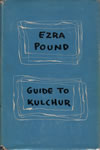
BK. Ezra Pound
 |
|||
| ‘The whole civilization reflected in Noh is a high civilization.’ |
45. Guide to Kulchur. 1938. Reprint, New York: New Directions, 1970.
Pound’s application of the ideogramic method (see 32) to a definition of culture and civilisation turns often to his perception of a need in the West for an infusion of knowledge of East Asian tradition. Chinese tradition, especially as reprinted in Confucius (‘Kung’), is central, but Japanese subjects appear frequently as well. Includes reference to Sadakichi Hartmann (pp. 309-10; see D12).
a. ‘Tradition, I’. Pound’s ‘ideogramic’ definition of ‘CIVILIZATION’ begins with reference to the ‘“Listening to Incense”’ of ‘the Imperial Court of Nippon’: the ‘companions . . . burnt now one perfume, and now another, or a mixture of perfumes, and the accomplishment was both to recognize what had gone materially into the perfume and to cite apposite poems’; the ‘interest’ in this activity, Pound writes, ‘is in the blend of perception and of association . . . a pastime neither for clods nor for illiterates’. Miner (A25) notes that Pound’s understanding derives from a confusion of homonymous Japanese verbs kiku (to listen, and, as of medicine, to work or to effect a remedy), and Meredith (A26) calls the misunderstanding ‘illiteracy of a very high order’, but the mistake is traceable to Brinkley (in D14), whom Pound cites in an earlier reference to the point (see 17b). Davis (119) argues that Pound’s understanding of ‘listening to incense’ is a source of structure in The Cantos. See also 17b and 77g.
b. ‘Tradition, II’. Contrary to Pound’s assertion to Quinn twenty years earlier that the nô is ‘too damn soft’ (see 59f), here he finds that ‘the whole civilization reflected in Noh is a high civilization’, not merely ‘painting on silk or nuances’, for in Kumasaka (17g) ‘the ghost . . . returns not from a grudge and not to gain anything’, but ‘to state clearly that the . . . young man who had killed him had not done so by a fluke or a slip’, and in Kagekiyo (21a), as well, one finds a ‘Homeric robustness’. This understanding of the dignity of Kumasaka and Kagekiyo returns to Pound at Pisa, in cantos LXXIV and LXXIX (56a and d), associated in the first instance with the nobility of understanding the strength of an adversary, contrasted in the second with European deceitfulness and ‘vulgarity’.
 |
 |
||
| Henri Gaudier-Brzeska
( |
|||
c. ‘March 12th’. ‘A civilized man is one who gives a serious answer to a serious question’, Pound begins, and ‘the VOU club [see 46] supplies . . . such an answer’ not only to Pound’s ‘particular question’ about the activities of ‘young Japan’ but also ‘to half dozen others whereon a deal of occidental ink has vainly flowed’. The chapter proceeds in large part with Pound’s quotation of correspondence from Kitasono, about the ‘formation of poetry’ and ‘relation between imagery and ideoplasty’, which Pound equates with the poetics of William Carlos Williams and the ‘sculptural principles’ of Gaudier[-Brzeska]. See also p. 180 for further conflation of the ‘aesthetic’ of Williams with Kitasono’s poetics, and p. 242 for Pound’s note that while he spent eight years ‘demanding a proper English edtn. of Frobenius’, Kitasono ‘has an article on Paideuma in VOU within the minimum of time after receiving the volume’; see Sullivan (124) for an argument that Kitasono’s theories as outlined here are central to Pound’s poetics.
d. ‘Savoir Faire’. Includes a plea for bilingual editions of ‘the best hundred books in ideogram’, which Pound hopes ‘Tokio’ might provide us (in the West) before we ‘are many more decades deader, older, stupider and void of perception’. Specific works Pound mentions are mainly from the Chinese classics, but the editions would include as well ‘a few dozen Noh dramas’ (p. 147). See 48, 49, 51, and 76d for Pound’s continued insistence on the importance of the point.
e. ‘The Culture of an Age’. The point made is that ‘the foreign eye’ may see what the native eye misses, and a case in point is Itô (Ap), who ‘after he had seen Umewaka Minoru’s photo [Ap] on [Pound’s] mantle shelf’, ‘opened up’, so that ‘there were no barriers of race or distance’. See also 82c1.
f. ‘Kung’. Pound’s discussion of ‘THE LESSON of Chinese history’ revolves around accusations that Europe has misunderstood and not properly tried to understand East Asia, and includes admission that ‘to separate what is Chinese and what Japanese needs more knowledge’ than Pound has or is ‘ever likely to come by’, for ‘we [in the West] are in a thick fog of ignorance’ about both civilisations. Examples of the point are drawn from a supposed ‘pre-Confucian’ practice of seppuku, the ritual suicide associated with the samurai, in China, and from ‘Japanese poets imitating Chinese as Europeans in the seicento wrote latin’. Pound repeats the latter point in correspondence with Kitasono and in the Japan Times two years later (see 53, 82b6, and also 76b).

